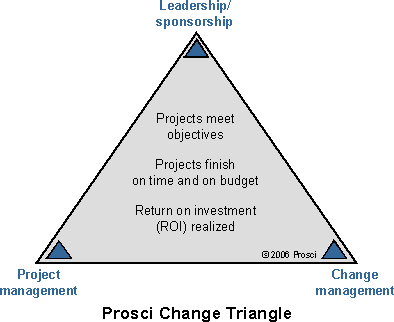|
Introduction
Why do some change initiatives fail while
others succeed?
The answer is not as complex as you might
think. Prosci's research with organizations from public and private
sectors reveals that the secret behind successful transformations can
be distilled into a simple yet powerful model described by the Prosci
Change Triangle. We would like to present this
model and help you assess if you have the necessary ingredients for
success.

Think of the Prosci
Change Triangle as a three-legged stool. The first
leg is executive leadership. This leg represents the
formulation of the strategy and direction for an organization, and the
required leadership to set the necessary changes into motion. The
second leg is project management. This leg
represents the fundamentals of managing a project, including the design
of work tasks and the management of resources to implement a change on
time and on budget.
The final leg is change management – the
people side of the change. This leg represents the actions taken by the
organization to help employees transition from the current state to the
desired future state.
In most cases when projects struggle or
fail, one of these three critical elements is missing or weak. For
example, absence of a clearly defined vision and strategy that align
with the change creates 'priority-setting paralysis,' especially when
multiple projects are competing for limited investment dollars and
resources. Likewise, poorly defined changes that lack a clear future
state or that have ineffective project management never gain traction.
Finally, changes that fail to manage the people side of change
encounter employee resistance that rob projects of their return on
investment.
|